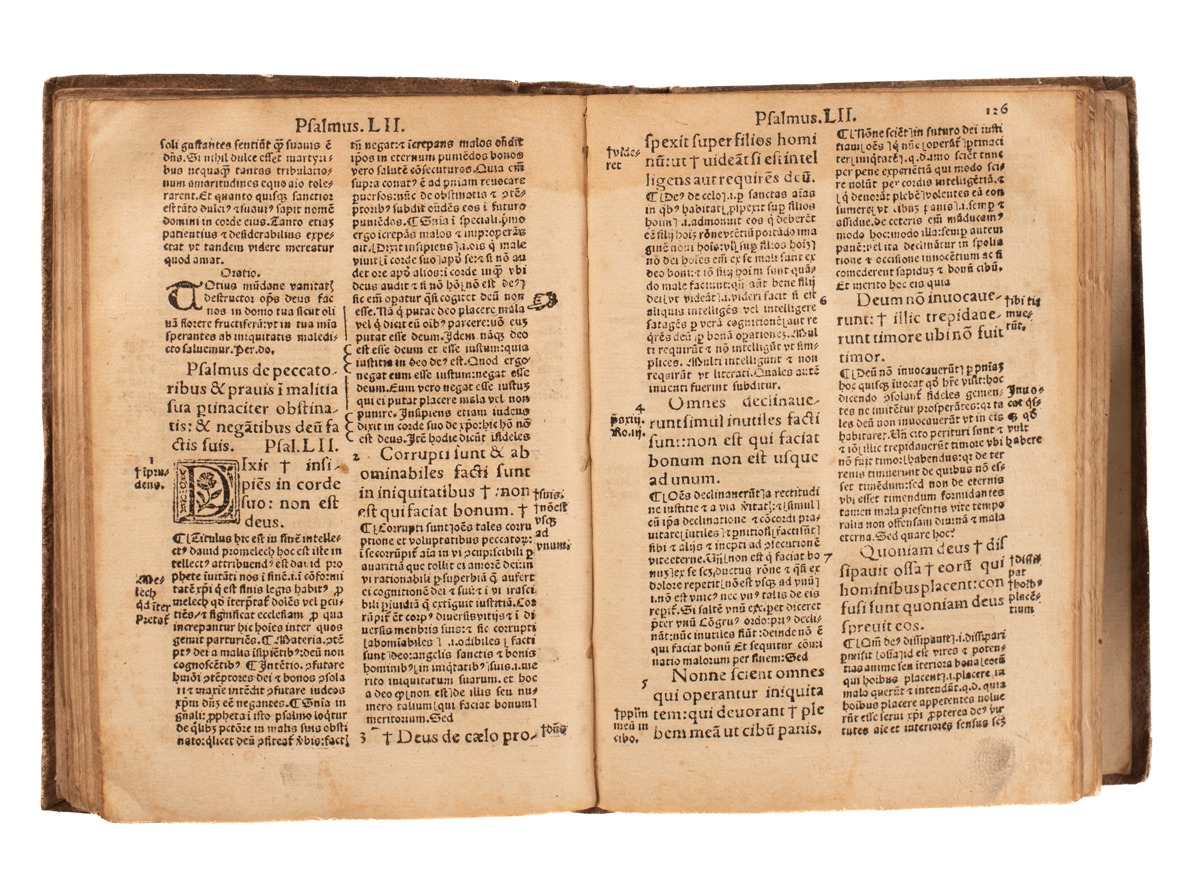
A MODEL TO IGNATIUS
LUDOPHUS of Saxony.
In Psal. David, diligentiss. Simul, & doctissima Enarratio ....Ad cuius ornamentum & collocupletatione[m] indices, cum Psalmoru[m], tum reru[m] haud segniter restitutos adauctosq[ue] assuimus. Sed nec Co[n]fesionales ac poenitentiales Psalmos authore Petrarcha .... Porro aute[m] ne quid desyderare possis, inserta est margini iuxta Hiero. recepta[m] versione[m] Diui August. ab Hebr[a]eo in Latinu[m] sermone[m] perquam docta traductio.
[Lyons,] A. Vincent, [1542].
8vo, ff. [l], 372, [4]; title printed in red and black framed by a historiated woodcut border, 4-line woodcut initials throughout, running titles, printed shoulder notes; some waterstaining to a handful of leaves, occasional further stains or smudging, bookblock partly detached from spine but holding firmly; in modern brown cloth, somewhat discoloured, remains of paper label on spine.

Added to your basket:
In Psal. David, diligentiss. Simul, & doctissima Enarratio ....Ad cuius ornamentum & collocupletatione[m] indices, cum Psalmoru[m], tum reru[m] haud segniter restitutos adauctosq[ue] assuimus. Sed nec Co[n]fesionales ac poenitentiales Psalmos authore Petrarcha .... Porro aute[m] ne quid desyderare possis, inserta est margini iuxta Hiero. recepta[m] versione[m] Diui August. ab Hebr[a]eo in Latinu[m] sermone[m] perquam docta traductio.
Uncommon and significant edition of one of the most important fourteenth-century commentaries on the Psalms, hailed as excellent for its method and clarity and first put through the press in 1491.
The significance of this edition lies in the context of its publication. Ludolphus was notable for developing, in his commentaries, the spiritual sense of biblical text. His emphasis on contemplation, and on the affective functions involved in meditating words and events was pivotal in the development of techniques of Christian meditation. Picturing the biblical scene and immersing oneself in it (already championed by Aelred of Rievaulx and St Bonaventure) became a method with Ludolphus, and contributed to the spread of the Devotio Moderna.
One of Ludolphus’s works, the Vita Christi, was translated into Spanish in 1502 and printed in Alcala, popularizing the method. Only a few years after the printing of our Lyon edition, St Ignatius of Loyola used these techniques in his Spiritual Exercises, published in 1548. Ludolphus's Vita Christi is in fact mentioned in almost every biography of St Ignatius of Loyola, as he declared that he read it whilst recovering from a cannon-ball wound – in a Castilian translation. Ludolphus’s influence on the founder of the Jesuit order and of one of the most pervasive contemplation and analysis methods in Western history was strong: St Ignatius had desired to become a Carthusian, like Ludolphus, after his pilgrimage to Jerusalem, but was dissuaded by a Carthusian Prior. Even now, a particular closeness between the Carthusians and Jesuits remains (for example in the ‘fluid’ structure of vocational enquiries). Amongst others, Emily Ransom has argued for the centrality of Ludolphus’s writings in Ignatian spirituality, indeed calling the Exercises ‘a systematization of the affective method that Ignatius encountered in the Vita’ (‘St. Ignatius in the Affective School of Ludolph of Saxony’, Studies in the Spirituality of Jesuits 53/3 (2021), p. 20).
Gültlingen VII p. 116: 43; Pettegree, Walsby and Wilkinson 57640; USTC 140460.

